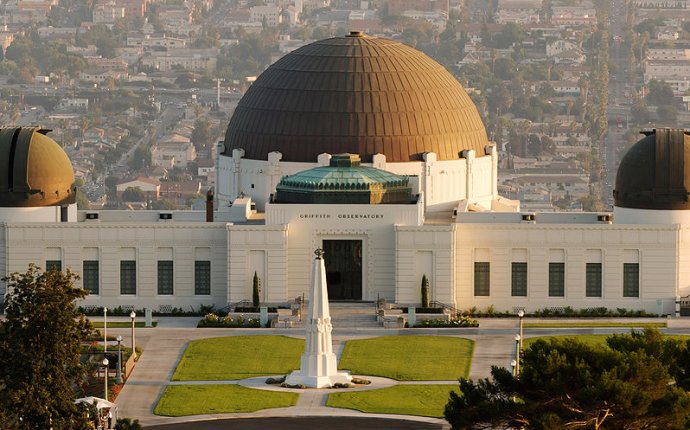
Nearest Observatory
If you plan to visit the observatory during the day there are daily tours for a small fee (For pricing information, visit our Tour Rates page). Tours begin at 10 AM, 11:30 AM and 1:30 PM, lasting about one hour each. During these tours, a guide will lead you to the telescope buildings where you can view the telescope from a gallery, and the guide will provide information about the telescopes. Observing through the telescopes is not available during the day. If you wish to request a tour for a large group (20 or more) please call 318-8726.
There is no charge to visit the Observatory, but donations are accepted. The recommended donation is $2/person.
A popular nighttime Public Program is the Nightly Observing Program (NOP) that includes a presentation, observing through a 16" telescope with assistance from a telescope operator, and a sack dinner. The NOP requires reservations (usually about one month in advance, and the program is suspended from mid-July through August due to weather conditions).
All details can be found by calling (520) 318-8726 or on the web, where you will find information on visiting Kitt Peak and the NOP (and details of the Advanced Observing Program (AOP) for the public).
The nearest campground is about 50 miles east of Kitt Peak in Gilbert Ray Campground, on Kinney Rd., 520-883-4200.
For information about visting Kitt Peak
Camping is not allowed at Kitt Peak. The mountain closes to the public at 4 PM each day. The nearest campground is about 50 miles east of Kitt Peak in Gilbert Ray Campground, on Kinney Rd. just west of Tucson, 520-883-4200.
Visit the Kitt Peak Virtual Tour
Kitt Peak celebrated its 40th anniversary in the fall of 1998 as described at . At that time a commemorative stamp set was issued by NOAO, marking the occasion.
A Brief History of Kitt Peak
Kitt Peak was selected in 1958 as the site for a national observatory after a 3-year survey that included more than 150 mountain ranges across the U.S. The Observatories on Kitt Peak are supported by the National Science Foundation. In 1957, the NSF entered into contract with the Association of Universities for Research in Astronomy, Inc., for the operation of Kitt Peak as a national center for optical astronomy. In 1982 the National Optical Astronomy Observatories was formed, consolidating management of the three national ground-based optical observatories which are Kitt Peak National Observatory, the National Solar Observatory with facilities at Kitt Peak and Sacramento Peak, New Mexico, and the Cerro Tololo Inter-American Observatory in Chile. Headquarters for NOAO are in Tucson, Arizona.
Kitt Peak, located in the Quinlan Mountains of the Sonoran Desert, comprises 200 acres of the nearly 3 million acre Tohono O'odham Nation. This land is leased by NOAO from the Tohono O'odham under a perpetual agreement that is valid for as long as scientific research facilities are maintained at the site.
For additional information:
- The Realm of the Long Eyes, James E. Kloeppel
- AURA and its US National Observatories, Frank Edmondson, 1997
According to the book, "Realm of the Long Eyes" by James E. Kloeppel:
The mountain was named by George J. Roskruge, who had arrived in the Arizona Territory in 1874 and became Pima County Surveyor. Among the many places Roskruge named in southern Arizona was Kitt Peak, which he named in honor of his sister Philippa (Roskruge) Kitt, who came to Arizona at his urging and died in 1900. The name Kitt Peak was finally made official by the United States Geographic Board in 1930.Before this time the Tohono O'odham name for the mountain was "Ioligam", meaning manzanita.
Galaxy Rotation Curves
Study of spiral galaxy rotation curves provided the first indication of dark matter in the universe. Dark matter may dominate over ordinary matter in regulating the dynamics of galaxies and the entire universe.
High Redshift Galaxies
By using radio emission as a selection criterion, the highest redshift galaxies have been discovered. The systematic study of these galaxies, with redshifts greater than 5 and dating back to very early epochs, has resulted in a new understanding of the rate of galaxy formation.
Galaxy Evolution and Environment
Observations of galaxy clusters indicate that the environment of a galaxy plays a strong role in its evolution. For example, the local density of galaxies can have an impact upon star formation and stellar populations in those galaxies.
Large-scale Structure
The discovery of a void in the constellation Boötes lead to an early indication of the large scale structure of the universe. Later research programs established that very large scale structures in the universe are probably not in equilibrium, causing major revisions in cosmological models.
The Distance Scale
Supernovae have produced significant results as distance indicators. Planetary nebulae have also proven to be an effective tools for measuring distances in the universe. These differing techniques are helping to determine the Hubble constant, a measure of the rate at which the universe is expanding.
Star Formation
Research has provided a more detailed understanding of the evolution of protostars and protoplanetary disks, an early step in star formation. Accompanying the formation of young stars are complex and frequently very large bipolar outflows.
Continued Role
With improvement of delivered image quality and the application of state-of-the-art instrumentation such as the CCD Mosaic Imager and the WIYN Telescope, Kitt Peak National Observatory continues to play a central role in astronomical research in the United States.
Kitt Peak National Observatory (KPNO) has its headquarters in Tucson and operates the Mayall 4-meter, the 3.5-meter WIYN, the 2.1-meter and Coudé Feed, and the 0.9-meter telescopes on Kitt Peak Mountain, about 56 miles southwest of the city in the Quinlan Mountains.











